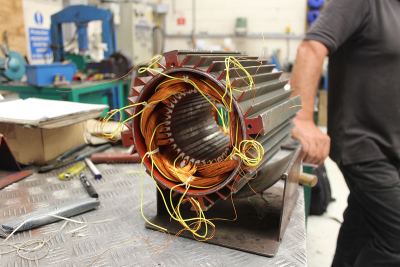 Add My Company
Add My Company
5 Signs Your Electric Motor Needs Rewinding

Electric motors are essential to countless machines and systems, from industrial equipment to home appliances. Over time, motors can wear out or fail and one of the most common issues is the need for a motor rewind, where the windings inside the motor are repaired or replaced. But how do you know when your motor needs to be repaired?
- Overheating
One of the most obvious signs that your electric motor is in trouble is overheating. If the motor runs too hot, it can cause severe damage to the windings inside, making a rewind necessary. Overheating can occur for various reasons, such as:
- Excessive load on the motor
- Blocked ventilation
- Improper lubrication
- Electrical faults like short circuits in the windings
You might notice the casing becoming extremely hot to the touch or hear strange noises as components struggle under the heat. If you experience persistent overheating, it’s a clear indication the motor needs attention, and rewinding might be required to repair damaged coils.
- Low Insulation Resistance
Insulation resistance is crucial for keeping your motor running smoothly. When the insulation on the windings begins to deteriorate, it leads to electrical leakage, which could short the motor. A drop in insulation resistance is often a warning sign of an impending failure in the winding insulation.
You may notice erratic motor performance, such as irregular speed, sudden stops, or trouble starting. Regular testing with a megohmmeter can help you spot issues early. If the readings are below acceptable levels, it’s time to consider a rewind to restore the motor’s insulation and keep it functioning safely.
- Reduced Motor Efficiency and Performance
If your motor isn’t performing as efficiently as it used to, this could indicate winding problems. You may notice:
- Reduced power output: The motor can no longer deliver the torque or speed it once could.
- Increased energy consumption: The motor draws more current than it should, often leading to higher energy bills.
- Slower starts or more frequent stalling: The motor struggles to operate smoothly, especially under load.
As the windings degrade or short out, the motor loses efficiency, and rewinding can help restore it to its original performance levels.
- Strange Noises or Vibrations
An electric motor should operate smoothly and quietly. If you begin hearing strange noises like grinding, humming, or buzzing, or you notice excessive vibration, these are major red flags. Noise and vibration can result from:
- Worn bearings
- Misalignment
- Imbalance
- Damaged or loose windings
When vibrations or noises are traced to damaged windings, a rewind can correct the issue. Neglecting these signs could lead to further mechanical damage, potentially requiring a more expensive repair or even full motor replacement.
- Burnt Odour or Visible Signs of Wear
If you detect a burnt smell coming from your electric motor or notice discoloration or burnt areas on the motor’s casing, it’s time for immediate action. These signs typically mean the windings have been damaged by heat, friction, or electrical faults. Burnt insulation on the windings is a clear signal that the motor has experienced a failure, and rewinding is often the best solution.
Visible signs like frayed wiring or exposed coils also indicate the motor’s winding has worn out and requires rewinding to prevent further damage.
If you’re noticing any of these issues, don’t wait around! A motor rewind can extend the life of your motor and ensure it continues to operate safely and efficiently. Routine maintenance, early diagnosis, and proper care can keep your electric motors running smoothly for years to come.
Need a rewind? Contact our motor rewinding service on 01621 868 138 to restore your motor’s performance and get it back in action.
For more information on 5 Signs Your Electric Motor Needs Rewinding talk to Gibbons Engineering Group Ltd
